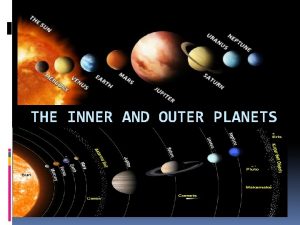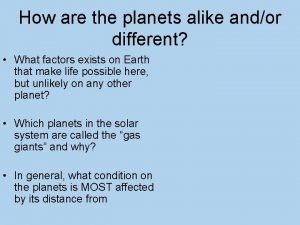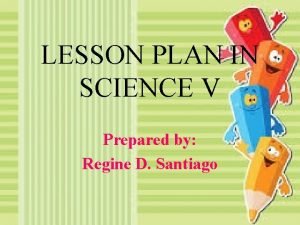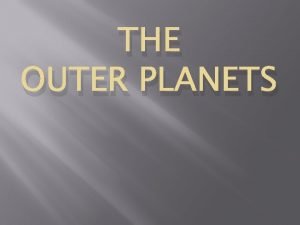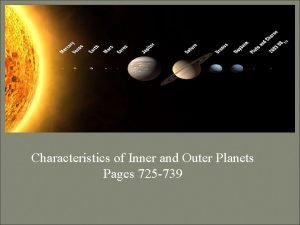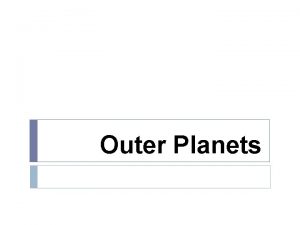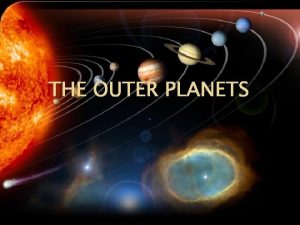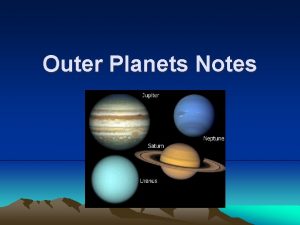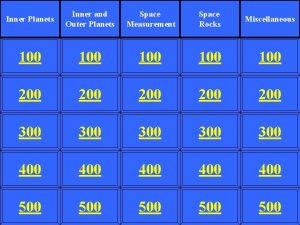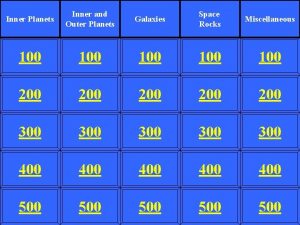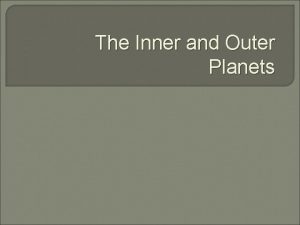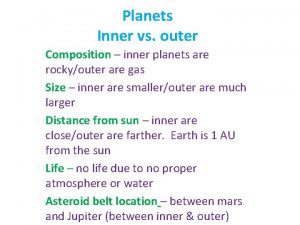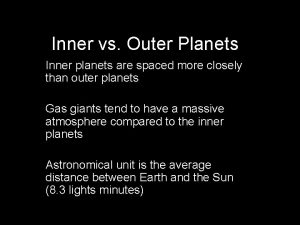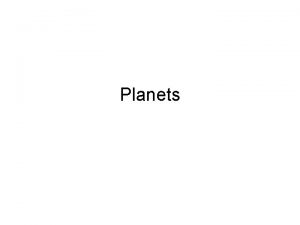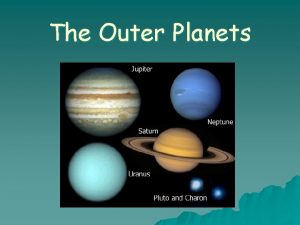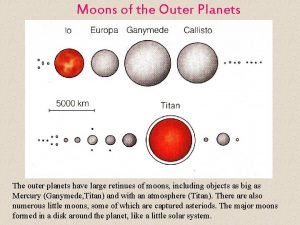Characteristics of Inner and Outer Planets Pages 725















- Slides: 15

Characteristics of Inner and Outer Planets Pages 725 -739

Characteristics of the Inner Planets They are 4 planets closest to the sun: Mercury, Venus, Earth and Mars. Located inside Asteroid Belt � Their insides, surfaces, and atmospheres formed in similar ways and follow similar patterns � • Very similar to each other, they are small and have rocky surfaces. They are dense. Do NOT have rings Often called “terrestrial planets” because they resemble Earth, “terra-” means “Earth” � All have rocky crusts and dense mantles and cores � 2

Processes and Surface Features � Tectonics • Processes of change in a crust due to the motion of hot material underneath � Volcanism • When molten rock moves from a planet’s hot interior onto its surface � Weathering & Erosion • When weather or small impacts break down rocks and the broken material is moved � Impact Cratering • When a small object hits a planet’s surface so fast that it causes an explosion 3

Mercury � � � � � Size- about 38% of Earth’s diameter it is 4878 km Distance from sun- about 39% of Earth’s distance it is 58, 000 km Surface- thin, hard rocky surface covered with many plains and craters Atmosphere- very thin, some sodium and other gases Ability to support life- none, there is NOT any sign of life on Mercury, lack of water and oxygen along with hot temperatures make life unlikely Moons- none Rotation- 59 Earth days Revolution-. 24 Earth years Daytime(sunlit side) temperature 430ºC Nighttime(shaded side) temperature -190ºC 4

Venus � � � � Size- slightly smaller than Earth 95% of Earth’s diameter, it is 12, 104 km Distance from sun- 108, 000 km from sun Surface- covered with rock similar to some parts of Earth, has volcanoes with lava flows and strange domes Atmosphere- Very thick and cloudy, mostly carbon dioxide, clouds partly sulfuric acid Atmospheric pressure is 90 times heavier than Earth’s and would crush a human Has clouds of sulfuric acid Ability to support life- Life does NOT appear to exist on Venus, lack of water along with harsh temperatures and atmosphere make life on Venus unlikely 5

Venus (cont’d) � � Sometimes called “Earth’s twin” or “Earth’s sister planet” due to similarity Retrograde rotation- rotates “backward” from east to west (opposite of Earth) Rotates very slowly, one rotation takes about 8 Earth months and one revolution around sun takes about 7. 5 Earth months (One day is longer than one year) Moons- None 6

E a r th � � � � Size- 12, 756 km diameter Distance from Sun- 150, 000 km Surface- Crust is a solid rocky surface, 70% is covered by water Atmosphere- up to 100 km thick, made up of 78% Nitrogen, 21% Oxygen, 1% other gases Ability to Support Life- Life does exist on Earth. Gaseous oxygen, liquid water and moderate temperatures are hospitable for life on Earth Rotation takes 24 hours Revolution takes 365. 25 days Earth has one moon 7

Mars � � � Size- 53% of Earth’s diameter, it is 6794 km Distance from Sun-228, 000 km from sun Surface-Rocky surface with carbonite rocks high in iron, creating red color Polar ice caps contain frozen water and carbon dioxide Atmosphere- Very thin, with thin clouds Mostly carbon dioxide, only 1% of Earth’s atmospheric pressure Ability to support life- It is possible that primitive bacteria may have lived on Mars or may now live there but none has been found. Existence of liquid water makes life on Mars a possibility 8

Mars continued � Has polar ice caps of frozen water and frozen carbon dioxide � Rotation- 1. 03 Earth days � Revolution- 1. 9 Earth years � Mars has largest volcano in solar system, called Olympus Mons � Moons- 2 Phobos and Deimos 9

Characteristics of The Outer Planets These are the planets outside of the Asteroid Belt, they are: Jupiter, Saturn, Uranus, Neptune and the dwarf planets Pluto and Eris � Jupiter, Saturn, Uranus, and Neptune are called “Gas Giants”. They are much larger than Earth and do not have solid surfaces � Pluto and Eris are small and rocky, like the terrestrial planets. � The gas giants do not have well-defined surfaces but have deep atmospheres that are typically about 75% hydrogen, 24% helium, and 1% other elements � Gas giants likely have solid cores of rock, ice, frozen carbon dioxide and other compounds � 10

Jupiter � � � � � Size- It is 142, 800 km Distance from Sun- 778, 000 km Surface and atmosphere of gas and liquid it does not have a welldefined surface Ability to support life- Lacks water, oxygen and moderate temperatures needed to support life. NO known life Largest planet in solar system with 300 times the mass of Earth Rotation-. 41 Earth days (fastest) Revolution- 29 Earth years Moons- numerous, 16 that are 10 km or larger and many smaller ones Has dark rings Great Red Spot is storm on Jupiter, twice as big as Earth 11

Saturn � � � � � Size- 120, 540 km Distance from sun 1, 427, 000 km Surface and atmosphere of a gas giant, it does not have a welldefined surface but has syrup-like mixture of helium and hydrogen and a thick atmosphere of gaseous helium and hydrogen Ability to support life- Lacks water, oxygen, and moderate temperatures needed to support life Rotation- 0. 43 Earth days Revolution- 29 Earth years Moons- many, 25 that are 10 km or larger plus smaller ones Low density planet, could float in water Prominent rings- mostly chunks of ice and rocks 12

Uranus � � � � � Size- 51, 200 km Distance from Sun- 2, 871, 000 km Surface-consists of blue-green clouds made up of tiny ice crystals of methane, and rock. The crystals of methane have frozen out of the planet's atmosphere. Uranus' atmosphere is about 83% hydrogen, 15% helium and 2% methane. Ability to support life- Lacks water, oxygen, and moderate temperatures needed to support life, NO known life Rotation- 0. 72 Earth days, is retrograde rotation like Venus, and rotates on side Revolution- 84 Earth years Moons- 27 Rings- 11 dark rings 13

Neptune � � � � � Size- It is 49, 500 km Distance from Sun- 4, 497, 000 km Neptune's surface is probably similar to Uranus': various "ices" and Silicates (rock) with about 15% hydrogen, some water, and a little helium Atmosphere is mostly hydrogen and helium with a small amount of methane. Ability to support life- Lacks significant water, oxygen, and moderate temperatures needed to support life. NO known life. Rotation- 0. 67 Earth days Revolution- 165 Earth years Visible clouds in atmosphere Moons- 11 (NASA) 3 Very dark rings, 1 very faint ring

Pluto � � � � Size- about 17% of diameter of Earth. It is 2200 km Distance from sun- It is 5, 913, 000 kilometers Rocky, icy surface is very small Thin atmosphere of methane gas Ceres- new dwarf planet, it was classified as the largest asteroid in the Asteroid Belt (it is between Mars & Jupiter). Pluto- was classified as a planet, now classified as a dwarf planet Eris- new dwarf planet, past Pluto it is an icy body near the edge of our solar system. 15
 What separates the inner and outer planets?
What separates the inner and outer planets? What is each planet made of
What is each planet made of Inner planets and outer planets
Inner planets and outer planets Four outer planets in order
Four outer planets in order What is the 2nd smallest planet in our solar system
What is the 2nd smallest planet in our solar system What separates the inner and outer planets
What separates the inner and outer planets My very excited mother just
My very excited mother just How are the inner and outer planets alike
How are the inner and outer planets alike Inner outer planets venn diagram
Inner outer planets venn diagram Inner defender examples
Inner defender examples Characteristics of outer planets
Characteristics of outer planets Solar system characteristics
Solar system characteristics Characteristics of outer planets
Characteristics of outer planets Characteristics of outer planets
Characteristics of outer planets Characteristics of inner beauty
Characteristics of inner beauty Printed pages vs web pages
Printed pages vs web pages





